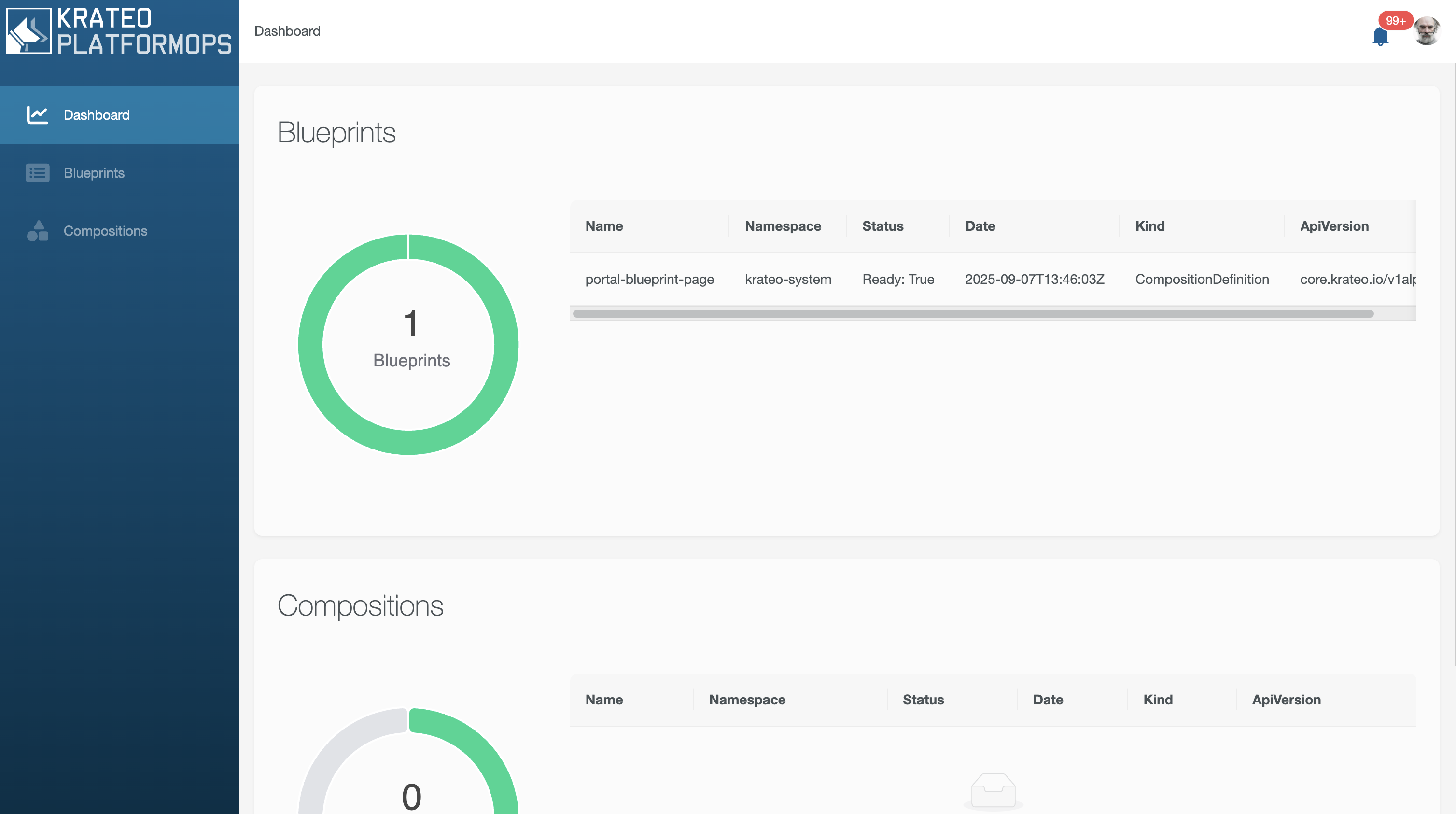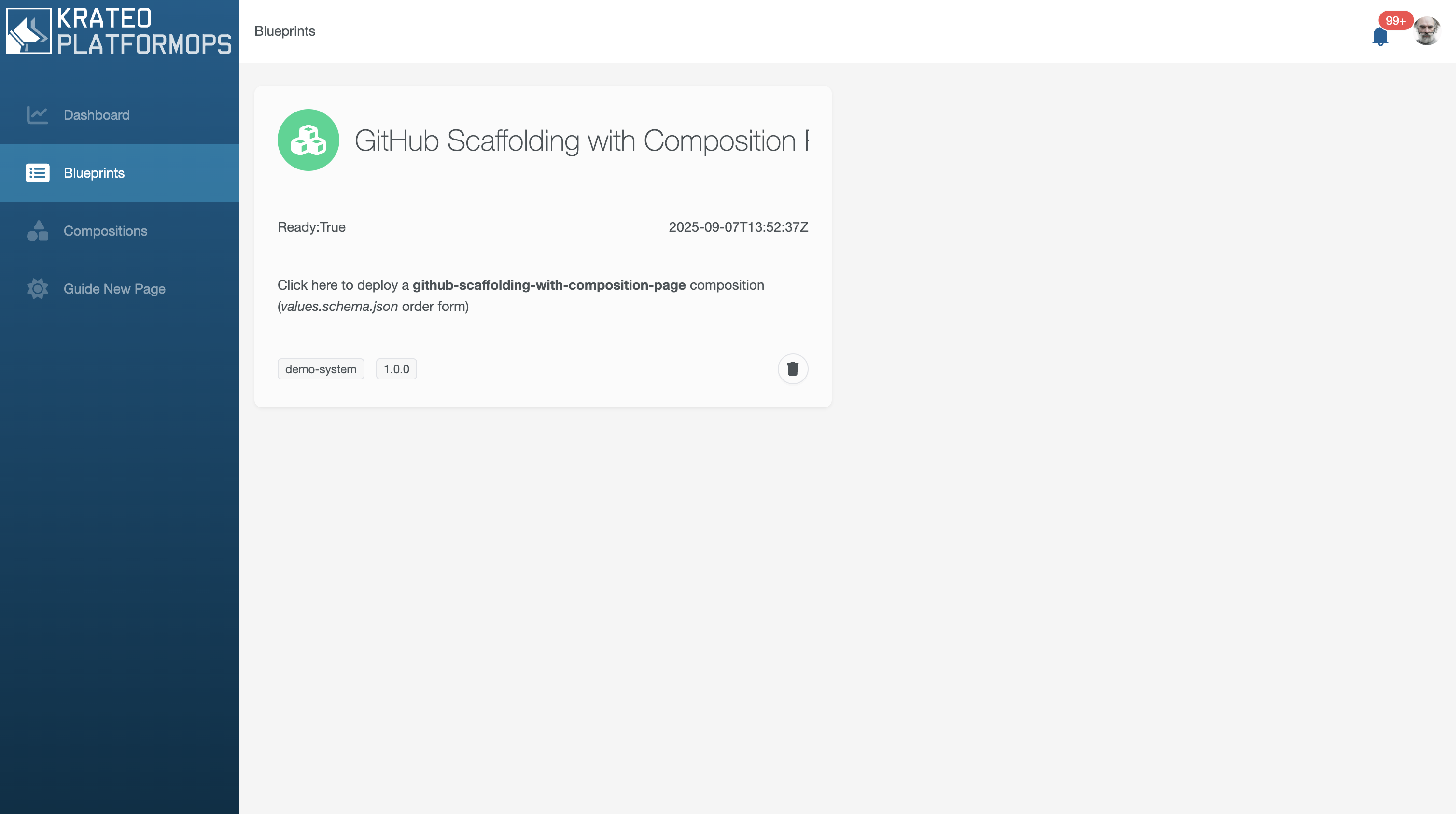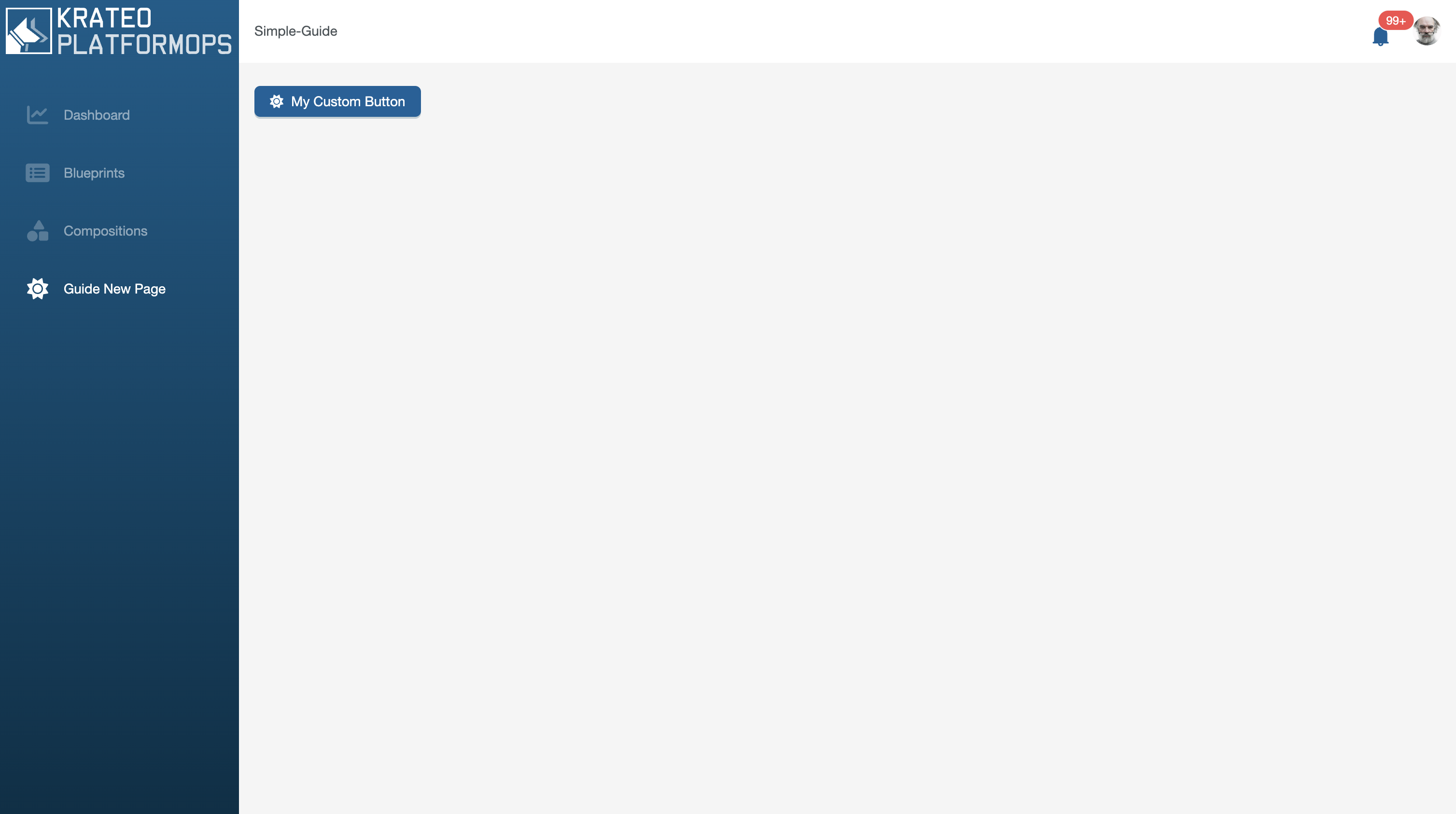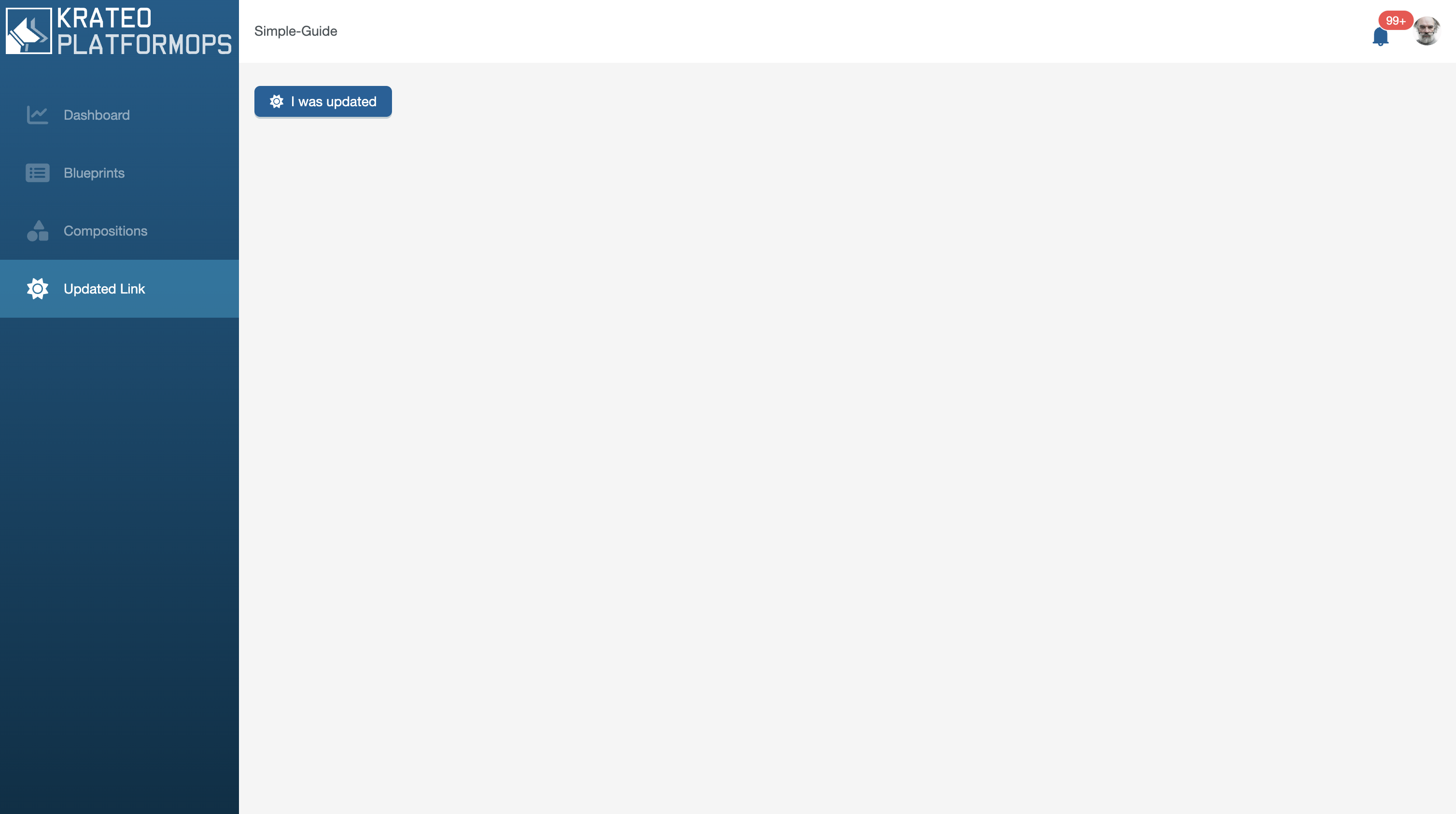Simple Page Guide
By following this guide you'll learn how to:
- create a Button widget
- Create a page widget that show the Button
- Create a link in the sidebar to navigate the page
Prerequisites
A cluster running krateo v2.5.1+
For testing/demo purposed a new cluster can be crated using kind (more info) by running:
curl -L https://github.com/krateoplatformops/krateo-v2-docs/releases/latest/download/kind.sh | sh
Launch this command to wait the Krateo platform to initialize
kubectl wait krateoplatformops krateo --for condition=Ready=True --namespace krateo-system --timeout=500s
When ready it will print:
krateoplatformops.krateo.io/krateo condition met
From now on you should be able to reach the Krateo's frontend at http://localhost:30080
Login
The credential to login this test cluster are
username: admin
password: created during init, retrievable running kubectl get secret admin-password -n krateo-system -o jsonpath="{.data.password}" | base64 -d (beware of trailing % symbol in the terminal, it is not part of the password)

The Krateo UI
After logging in you will be presented the Krateo's starter UI

Create a namespace for our widgets.
kubectl create ns simple-guide
Creating a Button widget.
The creation of a Button widget is as simple as applying a yaml a kind of type Button with the required properties inside spec.widgetData. (widgetData validation is run when doing an apply to make sure required properties are present)
cat <<EOF | kubectl apply -f -
kind: Button
apiVersion: widgets.templates.krateo.io/v1beta1
metadata:
name: simple-guide-button
namespace: simple-guide
spec:
widgetData:
icon: fa-sun
label: My Custom Button
clickActionId: none
actions: {}
EOF
To verify the widget has been correctly created, run
kubectl get button -n simple-guide
Showing the Button widget in a new Page
The Button widget is correctly created in the cluster, but in order for it to be visible is needs to be references by another visible widget.
We will insert the Button in a new Page widget.
cat <<EOF | kubectl apply -f -
kind: Page
apiVersion: widgets.templates.krateo.io/v1beta1
metadata:
name: simple-guide-page
namespace: simple-guide
spec:
widgetData:
allowedResources:
- buttons
items:
- resourceRefId: simple-button-id # <- this need to match the id of and item in spec.resourcesRefs
resourcesRefs:
items:
- id: simple-button-id
apiVersion: widgets.templates.krateo.io/v1beta1
name: simple-guide-button # <- matches metadata.name of the button widgetw e created
namespace: simple-guide
resource: buttons
verb: GET
EOF
by examining the previous yaml we can see that we referenced our Button by name in spec.resourcesRefs.items[0] and added an id (simple-button-id).
Declaring resurces in spec.resourcesRefs is the way Krateo knows to load these widgets, they can be declare manually like in our case or dynamically (see resourcesRefsTemplate section in docs for more info.) This concept is generic to any widget and is used to load other resources.
Where is the Page?
We have created a Button and a Page that references the Button but nothing is yet visible in the UI.
Creating a new link in the sidebar
We need a way to navigato to this page, to do so we will create a NavMenuItem that point reference the newly created page by running
cat <<EOF | kubectl apply -f -
kind: NavMenuItem
apiVersion: widgets.templates.krateo.io/v1beta1
metadata:
name: simple-guide-nav-menu-item
namespace: simple-guide
spec:
widgetData:
allowedResources:
- pages
resourceRefId: page-id # <- reference the id of a widget declared below in spec.resourcesRefs
label: Guide New Page
icon: fa-sun
path: /simple-guide
order: 90 # <- this is used to order the item in the menu, anything with a lower order will be placed before this one
resourcesRefs:
items:
- id: page-id
apiVersion: widgets.templates.krateo.io/v1beta1
name: simple-guide-page # <- matches metadata.name of the page widget we created in the previous step
namespace: simple-guide
resource: pages
verb: GET
EOF
Now refreshing the page will show the newly navigation item in the sidebar

Visiting the new page
Clicking to the new sidebar menu will navigate to the path declared in the NavMenuItem spec.widgetData.path property and finally display our Button widget!

Recap
We created a hierarchy or widget declaratively
NavMenuItem -> Page -> Button
- Widgets load other widgets via by referencing them inside
spec.resourcesRefsand display them by using referencing theresourcesRefid insidespec.widgetData
Testing the declarative nature of widgets
Try editing the spec.label prop of the yaml file in guide-simple-button.yaml or guide-simple-navmenuitem.yaml and apply the changes.
cat <<EOF | kubectl apply -f -
kind: Button
apiVersion: widgets.templates.krateo.io/v1beta1
metadata:
name: simple-guide-button
namespace: simple-guide
spec:
widgetData:
icon: fa-sun
label: I was updated
clickActionId: none
actions: {}
---
kind: NavMenuItem
apiVersion: widgets.templates.krateo.io/v1beta1
metadata:
name: simple-guide-nav-menu-item
namespace: simple-guide
spec:
widgetData:
allowedResources:
- pages
resourceRefId: page-id # <- reference the id of a widget declared below in spec.resourcesRefs
label: Updated link
icon: fa-sun
path: /simple-guide
order: 90 # <- this is used to order the item in the menu, anything with a lower order will be placed before this one
resourcesRefs:
items:
- id: page-id
apiVersion: widgets.templates.krateo.io/v1beta1
name: simple-guide-page # <- matches metadata.name of the page widget we created in the previous step
namespace: simple-guide
resource: pages
verb: GET
EOF
After a refresh of the page you'll be able to see the changes reflected in the UI

Next steps
A Button that does nothing is not very useful, in the next guide we will see how to update the Button to trigger an action on click.
Next: Action button